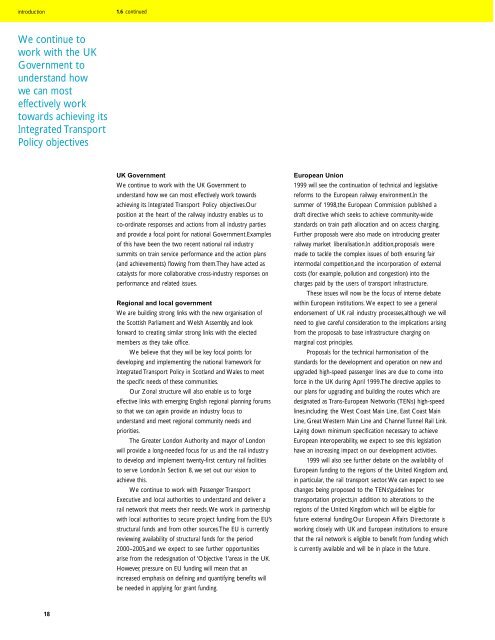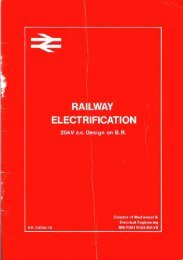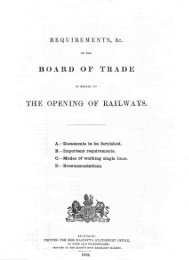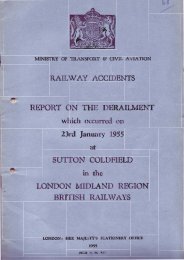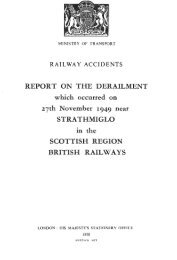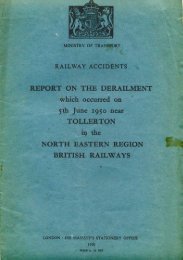R A I LT R AC K - The Railways Archive
R A I LT R AC K - The Railways Archive
R A I LT R AC K - The Railways Archive
Create successful ePaper yourself
Turn your PDF publications into a flip-book with our unique Google optimized e-Paper software.
introduction<br />
We continue to<br />
work with the UK<br />
Government to<br />
understand how<br />
we can most<br />
effectively work<br />
towards achieving its<br />
Integrated Transport<br />
Policy objectives<br />
18<br />
1.6 continued<br />
UK Government<br />
We continue to work with the UK Government to<br />
understand how we can most effectively work towards<br />
achieving its Integrated Transport Policy objectives.Our<br />
position at the heart of the railway industry enables us to<br />
co-ordinate responses and actions from all industry parties<br />
and provide a focal point for national Government.Examples<br />
of this have been the two recent national rail industry<br />
summits on train service performance and the action plans<br />
(and achievements) flowing from them.<strong>The</strong>y have acted as<br />
catalysts for more collaborative cross-industry responses on<br />
performance and related issues.<br />
Regional and local government<br />
We are building strong links with the new organisation of<br />
the Scottish Parliament and Welsh Assembly, and look<br />
forward to creating similar strong links with the elected<br />
members as they take office.<br />
We believe that they will be key focal points for<br />
developing and implementing the national framework for<br />
Integrated Transport Policy in Scotland and Wales to meet<br />
the specific needs of these communities.<br />
Our Zonal structure will also enable us to forge<br />
effective links with emerging English regional planning forums<br />
so that we can again provide an industry focus to<br />
understand and meet regional community needs and<br />
priorities.<br />
<strong>The</strong> Greater London Authority and mayor of London<br />
will provide a long-needed focus for us and the rail industry<br />
to develop and implement twenty-first century rail facilities<br />
to serve London.In Section 8, we set out our vision to<br />
achieve this.<br />
We continue to work with Passenger Transport<br />
Executive and local authorities to understand and deliver a<br />
rail network that meets their needs. We work in partnership<br />
with local authorities to secure project funding from the EU’s<br />
structural funds and from other sources.<strong>The</strong> EU is currently<br />
reviewing availability of structural funds for the period<br />
2000–2005,and we expect to see further opportunities<br />
arise from the redesignation of ‘Objective 1’areas in the UK.<br />
However, pressure on EU funding will mean that an<br />
increased emphasis on defining and quantifying benefits will<br />
be needed in applying for grant funding.<br />
European Union<br />
1999 will see the continuation of technical and legislative<br />
reforms to the European railway environment.In the<br />
summer of 1998,the European Commission published a<br />
draft directive which seeks to achieve community-wide<br />
standards on train path allocation and on access charging.<br />
Further proposals were also made on introducing greater<br />
railway market liberalisation.In addition,proposals were<br />
made to tackle the complex issues of both ensuring fair<br />
intermodal competition,and the incorporation of external<br />
costs (for example, pollution and congestion) into the<br />
charges paid by the users of transport infrastructure.<br />
<strong>The</strong>se issues will now be the focus of intense debate<br />
within European institutions. We expect to see a general<br />
endorsement of UK rail industry processes,although we will<br />
need to give careful consideration to the implications arising<br />
from the proposals to base infrastructure charging on<br />
marginal cost principles.<br />
Proposals for the technical harmonisation of the<br />
standards for the development and operation on new and<br />
upgraded high-speed passenger lines are due to come into<br />
force in the UK during April 1999.<strong>The</strong> directive applies to<br />
our plans for upgrading and building the routes which are<br />
designated as Trans-European Networks (TENs) high-speed<br />
lines,including the West Coast Main Line, East Coast Main<br />
Line, Great Western Main Line and Channel Tunnel Rail Link.<br />
Laying down minimum specification necessary to achieve<br />
European interoperability, we expect to see this legislation<br />
have an increasing impact on our development activities.<br />
1999 will also see further debate on the availability of<br />
European funding to the regions of the United Kingdom and,<br />
in particular, the rail transport sector.We can expect to see<br />
changes being proposed to the TENs’guidelines for<br />
transportation projects,in addition to alterations to the<br />
regions of the United Kingdom which will be eligible for<br />
future external funding.Our European Affairs Directorate is<br />
working closely with UK and European institutions to ensure<br />
that the rail network is eligible to benefit from funding which<br />
is currently available and will be in place in the future.


